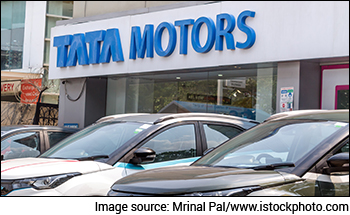Tata Motors: Is the Optimism Justified?

Before there was BYD there was PetroChina.
If you're wondering, I'm talking about Warren Buffett's investments in Chinese stocks.
Buffett's investment in the Chinese electric car manufacturer BYD has become the stuff of legends.
The stock is up a whopping 30x from Warren Buffett's purchase price. It is a fantastic investment whichever way you look at it.
However, there is another big Chinese investment that Warren Buffett made before he bought BYD. And it turned out to be as fantastic as BYD.
You see, Warren Buffett's annual report for the year 2003 had an unusual entry. Perhaps for the first time ever, there was a Chinese stock in Warren Buffett's portfolio.
And this was no small investment. The world's savviest investor had just spent a whopping US$ 500 m to buy a small stake in PetroChina.
It didn't take long for the motive behind his purchase to be revealed. Buffett helped connect the dots in the Berkshire Hathaway AGM later that year.
When Buffett picked up the annual report of PetroChina, he liked the fact that it controlled 3% of the world's oil production. He also observed that the company earned US$ 12 bn in profits, same as some of the largest companies in the US back then. Therefore, it was evident that he was looking at a very large company.
However, it was the company's valuations and its dividend policy that made him really sit up and take notice. He couldn't believe his eyes that the stock was trading at a PE multiple of close to 3x.
Yes, that's right. One of the world's largest oil and gas companies was trading at a mouth-watering PE of 3x.
But wait, the best is yet to come.
--- Advertisement ---
Investment in securities market are subject to market risks. Read all the related documents carefully before investing

Details of our SEBI Research Analyst registration are mentioned on our website - www.equitymaster.com
----------------------------------------
Somewhere in the report was a very important disclosure by the management. They laid out a policy where they promised to pay 45% of the profits as dividends. In other words, if the company was earning Rs 100 profits, Rs 45 would be paid out as dividends to shareholders.
Any doubts that Buffett harboured about the attractive valuations of PetroChina vanished into thin air.
A 45% dividend payout and a PE multiple of 3x meant that anyone buying the stock was almost guaranteed to earn 15% return on investment in the very first year itself.
One of the largest oil and gas companies in one of the largest economies of the world was available at a big, fat margin of safety.
It didn't seem to matter that Buffett had never looked at a Chinese stock before. It didn't seem to matter that China had a different culture and different policies. And it didn't seem to matter that Buffett had never met the management of PetroChina.
All that mattered was that the downside at a PE multiple of 3x was very limited for a company like PetroChina. The upside on the other hand was quite significant.
Buffett knew he had a great chance of making good returns in PetroChina. But the actual gains may have surprised even him.
He eventually sold Petrochina somewhere in 2007 and pocketed a cool US$ 3.5 bn in profits. Yes, a decision that would have taken him only a couple of hours to make, netted him and his firm a huge windfall.
Now, I know this piece is about Tata Motors and its future.
But there is a reason I decided to speak at length about Buffett and Petrochina. I want to use the same method to value Tata Motors that Buffett used for Petrochina.
--- Advertisement ---
Investment in securities market are subject to market risks. Read all the related documents carefully before investing
Choose Your Pick
Unnecessarily Risky Small Caps vs Small Caps Brimming with Opportunity
Discover the Small Cap Strategy Thousands of Equitymaster Subscribers Use
I'm interested
Details of our SEBI Research Analyst registration are mentioned on our website - www.equitymaster.com
---------------------------------------------
You see, Tata Motors has posted losses for 4 consecutive years starting from FY19. It last reported a profit back in FY18.
In fact, the period between FY12 and FY18 was a golden period for the company. It posted good profit numbers in each of these seven years.
So, let's try and value the company based on profits it earned during this period. I'm inclined to assume the average earnings per share of the company for this period as Rs 30 per share. This is because its diluted EPS ranged from Rs 22 per share to Rs 43 per share during this period.
You see, Warren Buffett valued PetroChina at a PE multiple of close to 10x. However, we believe that for a company like Tata Motors, a multiple of around 14-15x should be ideal.
So, here's how a valuation method for Tata Motors would look like: A PE range of 10x-15x.
Now, some basic math is all you need to figure out the price point below which the stock becomes attractive and the price point above which it becomes expensive.
This makes Tata Motors overvalued considering its current share price of more than Rs 500 per share.
I know some of you would think this kind of a valuation as ridiculous. A company like Tata Motors, which is innovating so well and which has some ambitious growth plans does not deserve to be valued based on its historical earnings.
It should be valued based on what its future earnings would look like. And it is here that there could be a huge upside.
--- Advertisement ---
Investment in securities market are subject to market risks. Read all the related documents carefully before investing
India's Lithium Megatrend is an Emerging Opportunity for Investors
We all know how oil producing countries made fortunes in the last century.
But now, the world is moving away from oil... and closer to Lithium.
Lithium is the new oil. That's the reason why India is focusing heavily on expanding its lithium reserves.
If you can tap into this opportunity, then there is a potential to make huge gains over the long term.
See Details Here
Details of our SEBI Research Analyst registration are mentioned on our website - www.equitymaster.com
---------------------------------------------
Now, the point is not whether one should value Tata Motors based on its past or future earnings. The point is whether one is aware of the edge of one's smartness and whether one is valuing the company based on this assessment of smartness.
I love what Warren Buffett's partner Charlie Munger said in the recently held Berkshire AGM. Here's him.
- 'We're not so smart but we kind of know where the edge of our smartness is. That is a very important part of practical intelligence.'
So, are you smart enough to predict what the profitability of Tata Motors would look like 5-10 years from now? Is that well within the edge of your smartness?
It's certainly not within the edge of my smartness to be honest. It's well outside it. I can't say if the electric vehicles that Tata Motors is so heavily betting on, will take off big time in India. Or in what shape or form Jaguar Land Rover would be few years down the line.
Auto is a very difficult industry. The competition here is intense and winners keep changing. Therefore, to predict that a company's earnings will be materially higher 5-10 years from now is very difficult in my view.
What I can however say with a reasonable amount of confidence is that Tata Motors is certainly capable of achieving an EPS of Rs 30 per share. It has done it in the past and there is a strong chance it may be able to do so in the future.
Now, the full year and the quarterly results of the company were announced last Friday. The company has performed really well and has posted an EPS of Rs 14 per share for the quarter.
Does this mean we should extrapolate this number and assume that Tata Motors will earn Rs 56 per share for the full year? Multiplying this by 15x would raise the fair value of the company from Rs 450 to Rs 840 per share and make it very attractive.
However, it all boils down to whether Rs 56 is even possible for the full year and whether it is sustainable over the long term.
Well, my answer would be that I don't know. I'm smart enough to know that it's capable of earning Rs 30-35 per share. But I'm not smart enough to figure out whether it will earn Rs 56 per share going forward.
This is my edge of smartness to be honest. An investor with a similar level of smartness as me may find the risk reward in his favour at or below Rs 300 per share and out of his favour above Rs 500 per share.
And this is precisely what Warren Buffett did.
He exited Petrochina as soon as it touched his edge of smartness or his idea of the fair value of the stock. Please note that Petrochina went up another 4x after Buffett sold his stake.
But Buffett preferred booking profits much earlier. Holding on to the stock would have meant stepping outside his circle of competence which he did not want to do.
The same applies for Tata Motors or any other stock for that matter. You need to first figure out your edge of smartness or circle of competence.
It's this edge that will decide how you want to value the stock. As someone has rightly said, the size of your circle of competence does not matter. What matters is knowing its boundaries.
An investor with a small circle of competence but a great understanding of its boundaries has a great long term advantage over the one with a huge circle of competence but a poor understanding of its boundaries.
Happy Investing.
Warm regards,

Rahul Shah
Editor and Research Analyst, Profit Hunter
Recent Articles
- Is this Famous Tata Stock a Hidden Trap for Investors? April 29, 2024
- A case study on why this Tata Stock might be overheated.
- Multibagger Stocks for the Next 10 Years April 28, 2024
- What are the potentially top 10 multibagger stocks for the long term? Find out...
- This Transformer Stock is About to Hit Rs 10,000. Is it Still Value for Money? April 27, 2024
- To scale up renewable energy generation in India, this company is looking to open more centres in India.
- Stocks Profiting from the Rise of the Luxury Class in India April 26, 2024
- These stocks benefit the most from the growing opulent class in India.
Equitymaster requests your view! Post a comment on "Tata Motors: Is the Optimism Justified?". Click here!
1 Responses to "Tata Motors: Is the Optimism Justified?"


Gunesh Apte
May 17, 2023Good Article. Your articles on valuations of HDFC AMC, IEX were also spot on.
I was thinking that, HDFC AMC P/E above 30 is not sustainable considering its low EPS Growth, and loss of Market share prior to FY23, and eventually that has proved correct just like you. HDFC AMC has seen sharp correction due to contraction of P/E in past one year.
I would like to see similar articles on valuations of TCS, Infosys, and emerging technology companies as well.